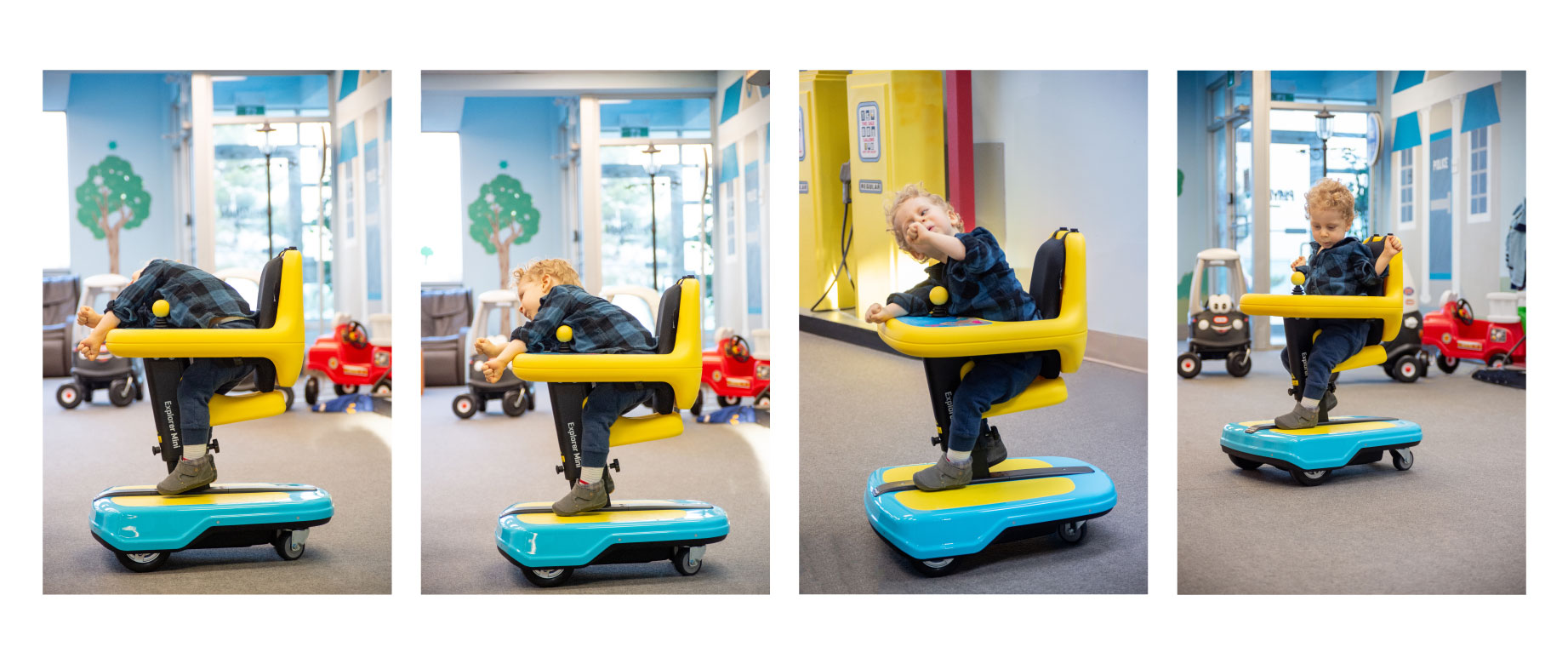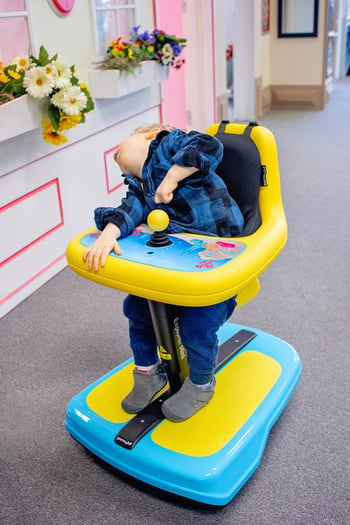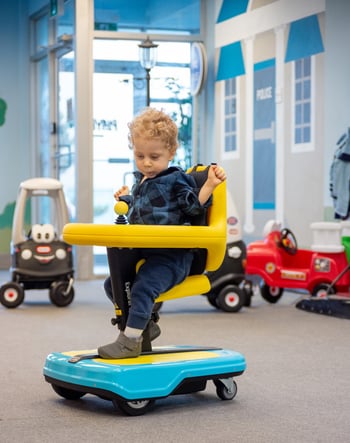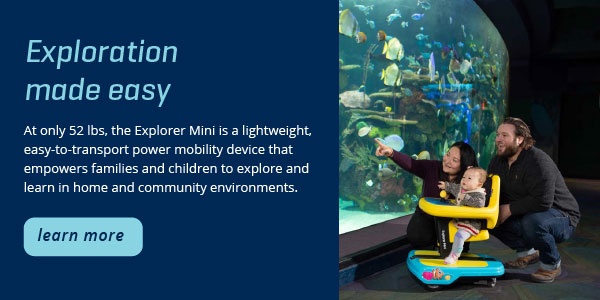Part 11 in our series about developmental milestones in early childhood focusing on mobility. See part 1, part 2, part 3, part 4, part 5, part 6, part 7, part 8, part 9, part 10, and part 12. Learn more about the Explorer Mini here.
The saddle seat was designed intentionally to facilitate an upright posture through developmentally appropriate supports. Research regarding the use of either flat seats or saddle-like seating has been conducted over the years. The work of DT Reid (1996) tells us that children with Cerebral Palsy displayed better seat alignment and postural control of the upper body resulting in a more efficient reaching path in a saddle seat making it easier to reach desired item. In 2006, Stavness reviewed the literature on the effect of positioning for children with cerebral palsy and upper extremity function. Evidence supports that an upright position, versus sitting back in a chair, improves reaching and hand manipulation. Additionally, the optimal position is a cutout tray, a sloped seat forward of 0-15 degrees and that the line of gravity be in front of the “sit bones”, otherwise known as the ischial tuberosities.
Recommendations for Seating
Sunny Hill Health Centre for Children provide very specific parameters of optimal seating for children with Cerebral Palsy (CP) based on extensive research. Their aim in creating these recommendations was to develop symmetry of the pelvis, trunk, neck and head in all positions. They suggest:
- Change positions to encourage motor development and movement
- Introduce sitting at around 5 months gradually bringing them into a more upright posture to encourage head control
- If needed provide lateral supports and a thigh guide to encourage hip abduction and external rotation and aligned foot position
- Aim for hip abduction of 15-30 degrees and external rotation of 5-15 degrees.
The shape of the saddle seat is designed to provide this hip abduction and external rotation while weight bearing through the feet. While it is not essential that your young child always be in this position, it is optimal for hip bone growth and development. For children who are not crawling or walking this helps develop the hip joint and head of the femur (thigh bone). The weight bearing in this position helps build a cup like structure around the hip joint for stability.
These recommendations are not just for children with CP, they are developmentally aligned for all children with mobility impairments.
Incorporating the research findings regarding the development of young child sitting skills, the Explorer Mini saddle seat is designed to optimize weight bearing on the ITs by not including padded seating. The Explorer Mini is not designed for children to use continuously, therefore padding is not necessary. As always, each child is different and skin care checks should be routine when altering a young child’s position.
You may wonder why the seat does not offer a seat belt. The seat and tray table as well as the foot support are designed to allow for dynamic movement. If movement is not encouraged the muscle fibers and nerve endings become static and do not communicate the messages of movement to the brain. By placing a seat belt on the device, we would restrict movement and not facilitate an upright posture. If your child cannot sit upright at first, do not give up.

Work with the therapist to find the best seat height to encourage this level of support. Remember your child is learning. When a child is learning to crawl, we let them struggle and fail before they finally achieve the skill. The same is true for upright sitting in the Explorer Mini. They may not be instantly successfully. But be assured we have worked with great intention to know how to assist in development of posture, environmental exploration and movement.
What is Success?
The picture below show Davis when he was originally put in the device. Initially he was not putting weight through the seat and his abnormal reflexes had him leaning to one side.

The temptation was to go and straighten him out, provide supports to keep him upright. But we didn’t do that. Davis struggled and worked at getting his trunk more upright and saw the joystick that he wanted to reach. Over time during this session of 1 hour, Davis was successful at bringing his body to a more upright position. Is this position perfect? No, but neither was that first crawl attempt of a child without mobility impairments!

The Explorer Mini is a tool that can be used over time to allow very young children to get into developmentally appropriate positions to achieve a more upright posture, and as a result promote visual, sensory, and motor integration, and provide the opportunity for independent mobility. Success in the Explorer Mini may initially be measured by showing small gains or improvements in ability to maintain midline positioning for longer periods of time while visually locating or reaching for the joystick to help promote development of postural control, strength, and endurance required for self-initiated mobility.
Reid, D. T. (1996). The effects of the saddle seat on seated postural control and upper-extremity movement in children with cerebral palsy. Developmental Medicine and Child Neurology, 38, 805–815.
Stavness, C., (2006). The effect of positioning for children with Cerebral Palsy on upper-extremity function: A review of the evidence. PT and OT in Pediatrics, 26,39-52
Sunny Hills Health Centre for Children. (2014). Positioning for children with GMFCS Levels IV-V: Focus on Hip Health. Retrieved from sunny-hill-clinical-tool-for-hip-health-gmfcs-iv-v-2014.pdf
 Dr Teresa Plummer, PhD, OTR/L, ATP, CEAS, CAPS
Dr Teresa Plummer, PhD, OTR/L, ATP, CEAS, CAPS
Associate Professor in the School of Occupational Therapy at Belmont University
Dr Teresa Plummer, PhD, OTR/L, ATP, CEAS, CAPS is an Associate Professor in the School of Occupational Therapy at Belmont University in Nashville, TN. She has over 40 yrs of OT experience and 20 in the area of Assistive Technology. She is a member of the International Society of Wheelchair Providers, and the Clinicians Task Force. She is a reviewer for American Journal of OT and guest reviewer for many other journals. She has presented internationally, nationally and regionally particularly in the area of pediatric power mobility. She has authored journal articles and textbook chapters in the area of OT and pediatric mobility and access.

